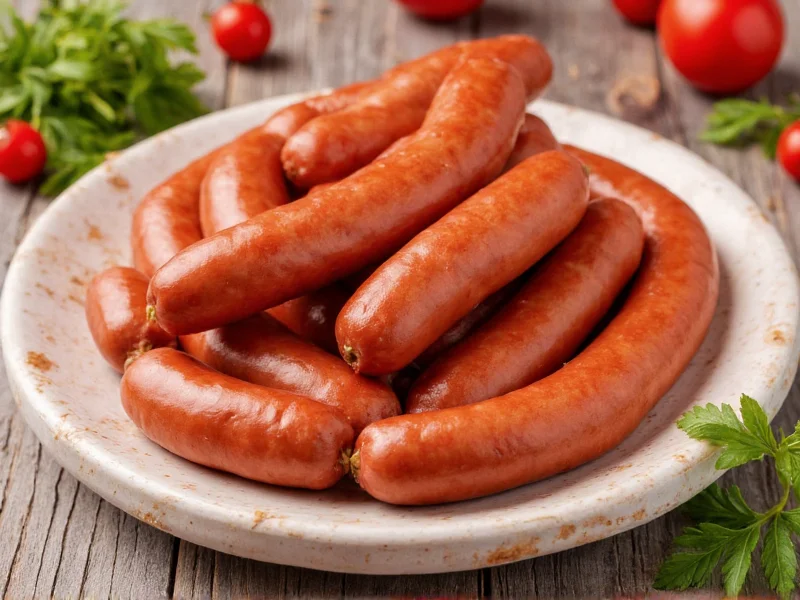When searching for ‘opas sausage,’ most culinary experts recognize this as a probable reference to family-style homemade sausages rather than a commercial product. The confusion often stems from German or Dutch heritage recipes where ‘Opa’ (meaning grandfather) denotes traditional preparation methods passed through generations. These artisanal sausages typically feature coarse-ground pork, natural casings, and regional spice blends reflecting European culinary heritage.
Understanding the ‘Opa’ Sausage Tradition
The term ‘Opa’ sausage originates from German-speaking communities where family recipes carry personal significance. Unlike standardized commercial products, these sausages vary by household but commonly share these characteristics:
| Characteristic | Typical Composition | Preparation Method |
|---|---|---|
| Meat Base | Pork shoulder (70-80%), sometimes with veal or beef | Coarsely ground (8-10mm plate) |
| Seasoning Profile | Marjoram, nutmeg, white pepper, garlic, mustard seeds | Dry rub before stuffing |
| Casing Type | Natural hog casings (32-36mm) | Hand-stuffed with moderate tension |
| Cooking Method | Smoked or fresh (uncooked) | Pan-fried or grilled over medium heat |
Common Misinterpretations of ‘Opas Sausage’
Several legitimate sausage varieties are frequently confused with ‘opas sausage’ due to phonetic similarities:
- Choripás - A Spanish-Argentinian sausage often misspelled as ‘choripas’ that could be misread as ‘opas’
- Bratwurst - Sometimes called ‘Opa’s brats’ in family recipes
- Metworst - Dutch dried sausage occasionally referenced in family contexts as ‘Opa’s worst’
- Thuringer - German smoked sausage with regional variations called ‘Opa’s style’
Culinary Applications for Traditional Family-Style Sausages
Whether you’re working with authentic German ‘Opa’ recipes or similar artisanal sausages, proper preparation maximizes flavor development. These cooking techniques apply to most coarse-ground fresh sausages:
- Pan-searing method: Heat cast-iron skillet to 325°F, prick sausages once, cook 12-15 minutes turning frequently until internal temperature reaches 160°F
- Beer-braising technique: Simmer in lager beer with onions for 20 minutes, then finish on grill for caramelization
- Traditional German pairing: Serve with sauerkraut cooked with apples and juniper berries, boiled potatoes, and sweet mustard
Regional Variations Across European Traditions
Family sausage recipes show remarkable regional diversity while maintaining core preparation principles. These variations demonstrate how ‘Opa’ style sausages adapt to local ingredients:
- Westphalian influence: Incorporates juniper berries and beechwood smoking
- Bavarian interpretation: Higher marjoram content with sweet paprika addition
- Dutch adaptation: Uses more garlic with a distinctive mustard seed coating
- American Midwest evolution: Often includes sage and maple syrup in sweet varieties
Creating Authentic Homemade Sausage
For those seeking to recreate traditional ‘Opa’ style sausages, proper technique matters more than specific recipes. Follow these professional guidelines for optimal results:
Maintain strict temperature control during preparation – keep meat below 34°F throughout grinding. Use a 70:30 lean-to-fat ratio for balanced texture. Chill all equipment beforehand and work quickly to prevent fat smearing. When seasoning, dissolve salt in 2 tablespoons of ice water per pound of meat to ensure even distribution. Allow stuffed sausages to rest refrigerated for 24 hours before cooking to develop flavor complexity.
Many home sausage makers encounter issues with casing integrity. Prevent bursting by avoiding overfilling – fill casings to about 80% capacity, leaving room for expansion during cooking. Natural casings require soaking in fresh water for 1 hour before use, while synthetic alternatives need different preparation methods.
Storage and Food Safety Considerations
Proper handling ensures both safety and quality preservation for homemade sausages. Fresh sausages maintain optimal quality for 2-3 days refrigerated at 38°F or below. For extended storage, vacuum-seal and freeze at 0°F, consuming within 3 months for best results. Never thaw sausages at room temperature – use refrigerator thawing over 24 hours or cold water submersion with water changes every 30 minutes.
When evaluating sausage freshness, look for consistent pink color without gray spots, firm texture that springs back when pressed, and clean meat aroma without sour or ammonia notes. Discard any sausage showing slime formation or discoloration.











 浙公网安备
33010002000092号
浙公网安备
33010002000092号 浙B2-20120091-4
浙B2-20120091-4